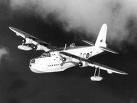|
Short S-25 Sunderland
 To meet requirement of the Royal Air Ministry for a general reconnaissance flying boat, Short developed the S-25 Sunderland from their famous S-23 "Empire" flying boat. The S-25 first flew on October 16, 1937. To meet requirement of the Royal Air Ministry for a general reconnaissance flying boat, Short developed the S-25 Sunderland from their famous S-23 "Empire" flying boat. The S-25 first flew on October 16, 1937.
The Sunderland had a deep hull, and the wings were set high on the fuselage, to keep the engines and propellers away from the water spray. The characteristic blunt nose contained a two-gun turret, and the tail a four-gun turret. To correct a problem with the center of gravity, the wings were given a slight sweepback; the result was that the engines were slightly toed out. The stabilizing floats under the wing tips were attached by two struts and wire-bracing.
Usually the Sunderlands were moored to a buoy. For this purpose, the front gun turret was rolled back and a chain was ran out. An anchor was on board, too. Daily maintenance was performed while the aircraft was moored. Supplies, fuel and ammunition were brought by boats. It was not uncommon for crews to live in their Sunderlandbetween flights.
The Sunderland was easy and pleasant to fly, but for long patrols the pilots had the benefit of an autopilot. Its cruising speed was about 225km/h and it usually flew patrols at low altitudes. The main task of many Sunderlands was tracking enemy shipping, flying long patrols over an empty sea.
U-boat patrols, carrying eight depth charges, were an important task of the Sunderlands. They patrolled the approaches, or flew convoy protection missions. The two were often combined, with the Sunderlands meeting the convoys at some distance in the ocean. When a U-boat was sighted, the Sunderlands tried to attack it before it submerged. Although described as "depth charges", its bombs were set to explode at a depth of 25 feet to 30 feet, effective enough against surfaced submarines.
The Sunderland was vulnerable to enemy fighters, because it was slow and operated out of the range of Allied fighters. However, the later Sunderlands were well-armed, with nose, dorsal and tail turrets, gun hatches in the aft fuselage, and often some additional guns added by the crews. Flying low above the waves to prevent attacks from below, a Sunderland was not an easy victim, and managed to defend itself very well.
Specifications, Sunderland Mk.V:
Engines: Four 1,200 hp Pratt & Whitney R-1830-65, twin wasp turbocharged radial piston engines
Weight, takeoff (kg): 29,484
Wing Span (meter): 34.38
Length (meter): 26.00
Speed (km/h): 343
Ceiling (meter): 5,455
Range (km): 4,330
Armament: 10*0.303 (7.7mm) guns, 2*0.50 (12.7mm) guns, and up to 2,250 kg of bombs and depth charges.
Back to History Index
 |
Antigua & Barbuda |
1994 |
Aircraft Sunderland over U-Boat-short Sunderlands hit at U-Boats |
 |
Barbados |
2003 |
Short Sunderland MK-II over a submarine |
|